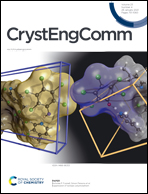Encapsulating organic guest cations in anionic MOFs that exhibit multi-responsive photochromism and photocontrolled luminescence†
Abstract
Photochromic materials with tunable luminescence have attracted considerable interest owing to their potential applications in various fields. However, making such materials with expected properties has always been a challenge. In this work, two metal–organic framework based host–guest compounds, [MV]·[Cd3(TPDC)4] (1) and [MV]·[Cd2(BTC)2(H2O)] (2) (MV·2NO3 = 1,1′-dimethyl-(4,4′-bipyridinium)dinitrate; H2TPDC = thiophene-2,5-dicarboxylic acid; H3BTC = 1,3,5-benzenetricarboxylic acid), have been synthesized by incorporating photoactive methyl viologen into an anionic metal–organic framework formed from cadmium cations and polycarboxylic acid ligands. Due to the presence of photoactive methyl viologen, both compounds exhibit electron-transfer photochromic behavior not only towards sunlight and indoor light irradiation but also towards X-rays. The photochromic response of compounds 1 and 2 originates from the carboxyl group to methyl viologen electron transfer. More interestingly, compounds 1 and 2 show good luminescence emission and their luminescence can be modulated upon sunlight irradiation.

- This article is part of the themed collection: Coordination Networks


 Please wait while we load your content...
Please wait while we load your content...